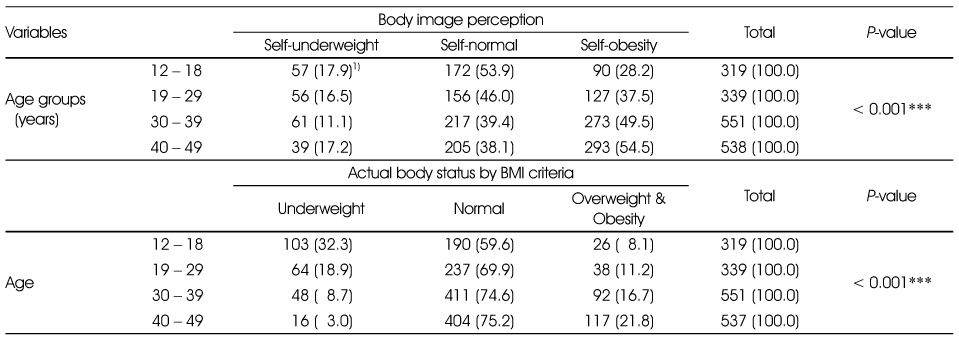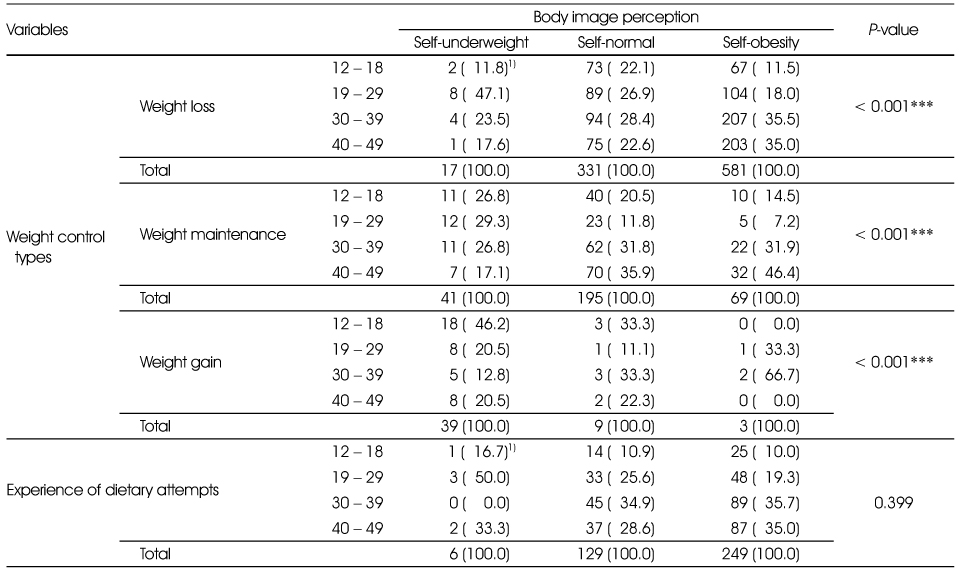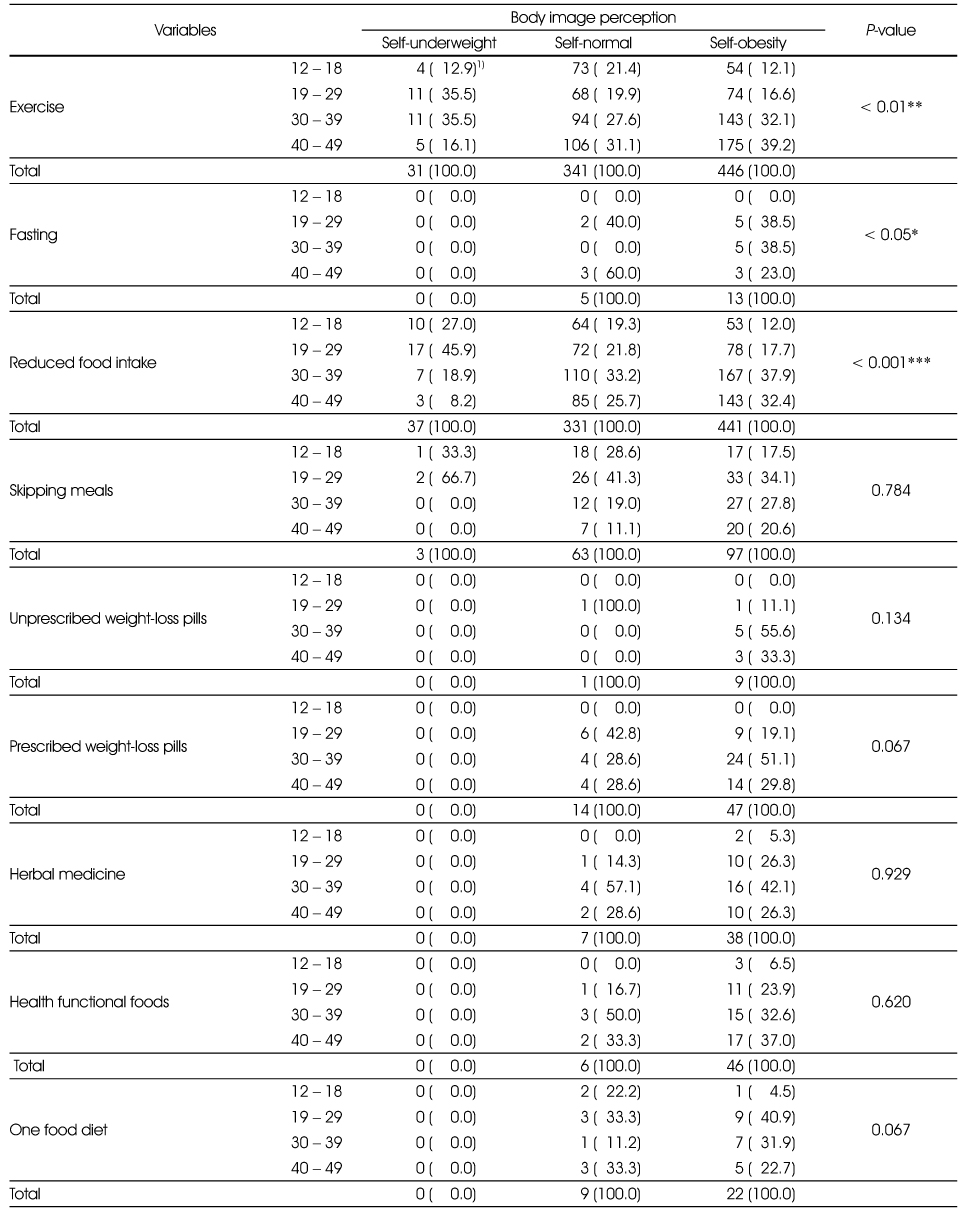Articles
- Page Path
- HOME > Korean J Community Nutr > Volume 20(2); 2015 > Article
-
Research Article
- Analysis of Weight Control Behaviors by Body Image Perception among Korean Women in Different Age Groups: Using the 2010 Korea National Health and Nutrition Examination Survey Data
- Young-Suk Lim, Na-Ri Park, Su-Bin Jeon, So-Yeon Jeong, Zuunnast Tserendejid, Hae-Ryun Park
-
Korean Journal of Community Nutrition 2015;20(2):141-150.
DOI: https://doi.org/10.5720/kjcn.2015.20.2.141
Published online: April 30, 2015
1Department of Food and Nutrition, Myongji University, Gyeonggi, Korea.
2Yong-in Center for Children's Foodservice Management, Gyeonggi, Korea.
- Corresponding author: Hae Ryun Park. Department of Food and Nutrition, Myongji University, 116, Myongji-ro, Cheoin-gu, Yongin, Gyeonggi 449-728, Korea. Tel: (031) 330-6204, Fax: (031) 330-6200, hrpark@mju.ac.kr
Copyright © 2015 The Korean Society of Community Nutrition
This is an Open-Access article distributed under the terms of the Creative Commons Attribution Non-Commercial License (http://creativecommons.org/licenses/by-nc/3.0/) which permits unrestricted non-commercial use, distribution, and reproduction in any medium, provided the original work is properly cited.
- 592 Views
- 5 Download
- 17 Crossref
Abstract
-
Objectives
- Self perceived body image among women is drawing a lot of attention in Korea due to their unhealthy weight control behaviors. To determine the relationship between self-perceived body image and dietary behaviors among Korean women, the discrepancy between actual body size and body image perception, weight control behaviors were assessed based on age groups using the 2010 KNHANES data.
-
Methods
- A total of 1,747 subjects were selected after eliminating those of likely changing their diet recently using the 2010 KNHANES data. The subjects were divided into 3 groups, self-underweight, self-normal, and self-obese according to their perception of body image. The BMI and weight control behaviors were assessed based on age groups according to the body image perception.
-
Results
- The younger, the higher ratio of underweight, women perceived their body size as normal or overweight. Exercise and reduced food intakes were dominant among various weight control methods but unhealthy methods were dominant among self perceived overweight group.
-
Conclusions
- Incorrect body image perception and unhealthy weight control behaviors can cause nutritional problems. Nutritional education should emphasize the importance of healthy weight and proper body image perception for Korean women.
- 1. Ahn Y, Kim H, Kim K. A study on weight control, nutritional knowledge, dietary attitudes and eating behaviors among high school female students. Korean J Community Nutr 2006; 11(2): 205-217.
- 2. Chin JH, Chang KJ. College students' attitude toward body weight control, health-related lifestyle and dietary behavior by self-perception on body image and obesity index. J Korean Soc Food Sci Nutr 2005; 34(10): 1559-1565.Article
- 3. Cho YJ. The comparative study on perception and satisfaction of somatotype of university woman students. J Korean Home Econ Assoc 2003; 41(11): 73-80.
- 4. Choi IS, Ro HK. A comparison study on middle school students of Gwangju and Jeonnam in terms of dietary behavior, body perception and weight control concerns according to BMI. J Korean Soc Food Sci Nutr 2010; 39(3): 383-391.Article
- 5. Chung SK. Weight control practices and body image of female college students. J Korean Soc Health Educ Promot 2001; 18(3): 163-175.
- 6. Her ES, Kang HJ, Lee KH. The factors associated with weight control experiences among adolescents - Based on selfesteem, body-cathexis, attitudes toward the body, anthropometric characteristics and perceptions of body shape -. Korean J Community Nutr 2003; 8(5): 658-666.
- 7. Hong EK, Park SB, Shin YS, Park HS. Body image perception and self-reported weight control activities in adolescent girls. J Korean Acad Fam Med 1997; 18(7): 714-721.
- 8. Hong MS, Pak HO, Sohn CY. A study on food behaviors and nutrient intakes according to body mass index and body image recognition in female university students from Incheon. Korean J Food Nutr 2011; 24(3): 386-395.Article
- 9. Im ES, Myeong SJ, Kang HY. Body image, weight-control self-efficacy, body mass index, and body weight control behavior of high school girls. J Korean Soc School Health 2013; 26(3): 195-204.
- 10. James DC. Gender differences in body mass index and weight loss strategies among african americans. J Am Diet Assoc 2003; 103(10): 1360-1362.ArticlePubMed
- 11. Janssen I, Katzmarzyk PT, Ross R. Body mass index, waist circumference, and health risk: evidence in support of current national institutes of health guidelines. Arch Intern Med 2002; 162(18): 2074-2079.ArticlePubMed
- 12. Kim BS, Lee YE. The relationship of food behaviors with body image and BMI of female college students in Jeonbuk province. Korean J Hum Ecol 2000; 9(2): 231-243.
- 13. Kim GS, Kang YJ. The effect of female adolescent bodyrelated variables, self-esteem and internal control on eating disorder behavior. J Korean Home Manage Assoc 2007; 25(3): 77-87.
- 14. Kim MO, Chang UJ. A study on the perception of obesity by age and the attitude toward weight control. Korean J Food Nutr 2009; 22(1): 110-122.
- 15. Kim OS, Kim KH. Weight, self-esteem, and depression in high school and college females. J Korean Acad Adult Nurs 2000; 12(3): 396-406.
- 16. Kim YK, Shin WS. A comparison study on perception of body image and dietary habits of high school students between urban and rural areas. Korean J Community Nutr 2008; 13(2): 153-163.
- 17. Koo JO, Park S. Analysis of BMI, body composition, weight control, dietary behaviors of adult women. Korean J Community Nutr 2011; 16(4): 454-465.Article
- 18. Lee HJ, Choi MR, Koo JO. A study of body image, weight control and dietary habits with different BMI in female high school students. Korean J Community Nutr 2005; 10(6): 805-813.
- 19. Lee JS, Ha BJ. A study of the dietary attitude, dietary selfefficacy and nutrient intake among middle school students with different obesity indices in Gyeong-Nam. Korean J Community Nutr 2003; 8(2): 171-180.
- 20. Lee JS, Yun JW. A study on perception about body image, dietary attitude, dietary self-efficacy and nutrient intake of high school students in Busan. J Korean Soc Food Sci Nutr 2003; 32(2): 295-301.Article
- 21. Lim ET, Kim Y. The relationship between the prevalence of constipation and beverage intake of female high school students in Seoul. Korean J Community Nutr 2003; 8(6): 856-866.
- 22. Lobstein T, Baur L, Uauy R. Obesity in children and young people: A crisis in public health. Obes Rev 2004; 5(s1): 4-104.ArticlePubMed
- 23. Oh DN, Kim EM, Kim SH. Weight control behaviors and correlates in Korean adolescents. J Korea Contents Assoc 2013; 13(3): 218-228.Article
- 24. Ryu HK, Park JA. Perception of body image, eating disorder, eating behaviors and subjective health status of female high school and college students in Daegu area. Korean J Community Living Sci 2002; 13(3): 69-80.
- 25. Suh YS, Kang HJ, Chung YJ. Difference in weight control status and eating behavior between dissatisfied and satisfied female high school students regarding their own body shape. Korean J Food Cult 2011; 26(4): 354-363.
- 26. Won HS, Han SS, Oh SY, Kim HY, Kim WK, Lee HS, Jang YA, Cho SS, Kim SH. Guidelines of body mass index in Korean childhood and adolescent obesity and relationship with physical strength. Korean J Nutr 2000; 33(3): 279-288.
- 27. Yeon JY, Hong SH, Bae YJ. A study on nutritional status and dietary quality of university students by body image. Korean J Community Nutr 2012; 17(5): 543-554.Article
- 28. Yoo WS, Kim Y. A study on eating disorders and it's related factors in high school girls. Korean J Community Nutr 2004; 9(3): 274-284.
REFERENCES
Figure & Data
REFERENCES
Citations

- Prediction model of weight control experience in men with obesity in their 30 s and 40 s using decision tree analysis
Myeunghee Han
Scientific Reports.2024;[Epub] CrossRef - The impact of weight loss diet programs on anemia, nutrient deficiencies, and organ dysfunction markers among university female students: A cross-sectional study
Osama Y. Althunibat, Sultan Ayesh Mohammed Saghir, Saleem Hmoud Aladaileh, Atikah Rawadieh
Electronic Journal of General Medicine.2023; 20(1): em436. CrossRef - Obesity-Status-Linked Affecting Factors of Dyslipidemia in Korean Young-Adult Men: Based on the Korea National Health and Nutrition Examination Survey (2019–2021)
Min Kwon, Jinheum Kim, Eunjeong Cha
Healthcare.2023; 11(14): 2015. CrossRef - Physical Activity and Quality of Life in Adult Men and Women with Distorted Perception of Weight Status: Nationwide Surveys (KNHANES 2016–2018)
Su-Jin Lee, Min-Gyu Lim, Jung hee Kim, Chulyong Park, YoungJi Ko, Myung-Gwan Kim, Chul-Hyun Kim, Aeryoung Kim, Jong-Moon Hwang
International Journal of Environmental Research and Public Health.2022; 19(16): 10417. CrossRef - Consumption of Weight-control or Health Functional Foods, Dietary Habits, and Weight Perceptions According to the Body Mass Index of Adult Women in the Chungcheong Area
Gayoung Seong, Munkyong Pae
Korean Journal of Community Nutrition.2022; 27(2): 81. CrossRef - What are the correlates of body image distortion and dissatisfaction among school-adolescents?
Houda Ben Ayed, Sourour Yaich, Maissa Ben Jemaa, Mariem Ben Hmida, Maroua Trigui, Jihene Jedidi, Imen Sboui, Raouf Karray, Habib Feki, Yosra Mejdoub, Mondher Kassis, Jamel Damak
International Journal of Adolescent Medicine and Health.2021;[Epub] CrossRef - Biochemical Index, Nutrition Label Use, and Weight Control Behavior in Female Adolescents: Using the 2010 and 2011 Korea National Health and Nutrition Examination Survey
Mi-Ja Choi, Hyun-Ju Jo, Mi-Kyung Kim
Clinical Nutrition Research.2020; 9(1): 32. CrossRef - The effects of body mass index and body shape perceptions of South Korean adults on weight control behaviors; Correlation with quality of sleep and residence of place
Nam E Kang, Seung Ju Kim, Yoon Sin Oh, Se-Eun Jang
Nutrition Research and Practice.2020; 14(2): 160. CrossRef - Factors influencing disordered eating behavior based on the theory of triadic influence
Jee Hee Han, Sun Ah Kim, Sue Kim, Jin Young Park
Perspectives in Psychiatric Care.2019; 55(3): 366. CrossRef - Comparison of factors affecting weight control experiences by perception types of body shape
Yeo Jeong Gu, Jae Yeon Jeong, Ji Yun Jeong, Hae Jong Lee
Korean Journal of Health Education and Promotion.2019; 36(4): 77. CrossRef - Relationships between Obesity, Body Image Perception, and Weight Control in Adult Women
Hyunju Chae
Korean Journal of Women Health Nursing.2019; 25(2): 129. CrossRef - Relationship between body image and weight status in east Asian countries: comparison between South Korea and Taiwan
Jin-Won Noh, Young Dae Kwon, Youngmi Yang, Jooyoung Cheon, Jinseok Kim
BMC Public Health.2018;[Epub] CrossRef - The Association of Food Label Use with Objective and Subjective Obesity among a Korean Population
In Sook Lee, Kowoon Lee
Journal of Korean Academy of Community Health Nursing.2016; 27(3): 262. CrossRef - The association of body image distortion with weight control behaviors, diet behaviors, physical activity, sadness, and suicidal ideation among Korean high school students: a cross-sectional study
Jounghee Lee, Youngmin Lee
BMC Public Health.2015;[Epub] CrossRef - Weight Control Behaviors, Health-related Quality of Life and Nutritional Status by Overestimation of Body Image among Young Korean Females: Data from the Fifth Korea National Health and Nutrition Examination Survey, 2010-2011
Seulki Park, Taisun Hyun, Hongmie Lee
Korean Journal of Community Nutrition.2015; 20(5): 362. CrossRef - A Comparison of Body Image and Dietary Behavior in Middle and High School girls in Gyeongbuk Area
Hye-Jin Kim, Kyung-A Lee
Korean journal of food and cookery science.2015; 31(4): 497. CrossRef - The Influence of Self-resilience on Dietary Management in Middle School Students
Yunhwa Kim
Korean Journal of Community Nutrition.2015; 20(6): 399. CrossRef
- We recommend
- Related articles
-
- Analysis of the relationship between sugar intake and cancer prevalence: a cross-sectional study using the 8th Korea National Health and Nutrition Examination Survey
- Trends in growth and nutritional status of Korean toddlers and preschoolers: a cross-sectional study using 2010–2021 Korea National Health and Nutrition Examination Survey data
- Total sugar intake and its contributed foods by age groups in Koreans using the 8th (2019–2021) Korea National Health and Nutrition Examination Survey: a cross-sectional study
- Estimating and evaluating usual total fat and fatty acid intake in the Korean population using data from the 2019–2021 Korea National Health and Nutrition Examination Surveys: a cross-sectional study
- Comparison of blood biochemical characteristics and dietary intake by sex in gastric cancer patients over 40 years in Korea based on 7 th (2016-2018) Korea National Health and Nutrition Examination Survey: a cross-sectional study
General characteristics of the subjects
1) N (%), Significant difference using Chi-square test at P < 0.05
***: P < 0.001
Average BMI and waist circumference by body image perception
1) Mean ± SE, Significant difference using ANOVA test, Duncana,b) at P < 0.05
***: P < 0.001
Discrepancy between the actual body status and body image perception of the subjects
1) N (%), Significant difference using Chi-square test at P < 0.05
***: P < 0.001
Parameters of general linear model of body image perception and BMI on age
1) BP=Body image perception, BP=1 (under weight), BP=2 (normal), BP=3 (obesity), Subpopulation: (Sex=Female & age >=12)
2) Set to zero because this parameter is redundant.
Model: BMI=(Intercept)+Body image perception+age. ***: P < 0.001
Weight control types and dietary attempts for weight control
1) N (%), Significant difference using Chi-square test at P < 0.05
***: P < 0.001
Methods for weight controls
1) N (%), Significant difference using Chi-square test at P < 0.05
*: P < 0.05, **: P < 0.01, ***: P < 0.001
1) N (%), Significant difference using Chi-square test at ***:
1) Mean ± SE, Significant difference using ANOVA test, Duncana,b) at ***:
1) N (%), Significant difference using Chi-square test at ***:
1) BP=Body image perception, BP=1 (under weight), BP=2 (normal), BP=3 (obesity), Subpopulation: (Sex=Female & age >=12) 2) Set to zero because this parameter is redundant. Model: BMI=(Intercept)+Body image perception+age. ***: P < 0.001
1) N (%), Significant difference using Chi-square test at ***:
1) N (%), Significant difference using Chi-square test at *:

 KSCN
KSCN






 PubReader
PubReader Cite
Cite


